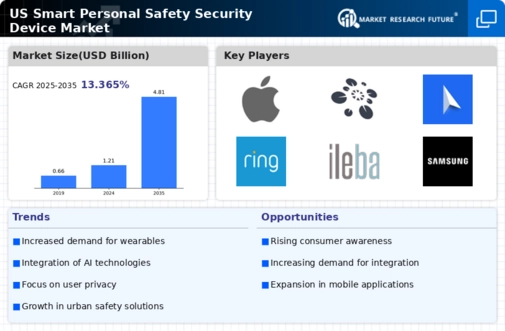The smart personal safety security device market is characterized by a dynamic competitive landscape, driven by technological advancements and increasing consumer awareness regarding personal safety. Key players such as Ring (US), ADT (US), and Vivint (US) are strategically positioned to leverage innovation and partnerships to enhance their market presence. Ring (US) focuses on integrating smart home technology with personal safety solutions, while ADT (US) emphasizes its extensive service network and customer support. Vivint (US) is known for its comprehensive smart home security systems, which include personal safety devices, thus appealing to a broad consumer base. Collectively, these strategies foster a competitive environment that prioritizes technological integration and customer-centric solutions.
In terms of business tactics, companies are increasingly localizing manufacturing and optimizing supply chains to enhance efficiency and reduce costs. The market appears moderately fragmented, with several players vying for market share. However, the influence of major companies like Ring (US) and ADT (US) is substantial, as they set benchmarks for service quality and technological innovation, thereby shaping the overall market structure.
In November 2025, Ring (US) announced the launch of its new AI-driven personal safety device, which utilizes advanced facial recognition technology to enhance user security. This strategic move is significant as it not only positions Ring (US) at the forefront of technological innovation but also addresses growing consumer concerns regarding privacy and security. The integration of AI into personal safety devices may redefine user expectations and set new industry standards.
In October 2025, ADT (US) expanded its partnership with a leading tech firm to develop a new line of wearable safety devices. This collaboration is crucial as it allows ADT (US) to tap into the growing trend of wearable technology, thereby diversifying its product offerings and enhancing its competitive edge. The partnership is likely to attract a younger demographic, which is increasingly inclined towards tech-savvy safety solutions.
In September 2025, Vivint (US) launched a subscription-based service that includes 24/7 monitoring of personal safety devices. This initiative reflects a shift towards service-oriented business models, which may enhance customer loyalty and provide a steady revenue stream. By offering comprehensive monitoring services, Vivint (US) positions itself as a leader in customer service and support, which could be a decisive factor in a competitive market.
As of December 2025, current trends in the smart personal safety security device market include a strong emphasis on digitalization, sustainability, and AI integration. Strategic alliances among key players are increasingly shaping the competitive landscape, fostering innovation and enhancing product offerings. The market appears to be shifting from price-based competition to a focus on technological advancement and supply chain reliability. This evolution suggests that companies will need to differentiate themselves through innovative solutions and robust customer engagement strategies to maintain a competitive edge.





















Leave a Comment